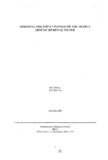| dc.contributor.author | Jakariya, Md. | |
| dc.contributor.author | Quaiyum, Md. | |
| dc.date.accessioned | 2019-11-20T07:57:57Z | |
| dc.date.available | 2019-11-20T07:57:57Z | |
| dc.date.issued | 2002-12 | |
| dc.identifier.citation | Jakariya, M., & Quaiyum, M. (2002, December). Assessing the effectiveness of the Shapla arsenic removal filter. Research Reports (2002): Health Studies, Vol - XXXIII, 71–85. | en_US |
| dc.identifier.uri | http://hdl.handle.net/10361/13035 | |
| dc.description.abstract | The study was conducted to assess the effectiveness of the Shap!a Arsenic Removal Filter.
The two villages of Sonargaon Upazila were sel~cted , as the use of this filter was mainly
concentrated there. A total of 50 Shapla filters were provided among the villagers by the
International Development Enterprises, Bangladesh free of cost under the arsenic mitigation
project, implemented by BRAC, in collaboration with Unicef and OPHE. Data were
collected through interview and observation in mid - August 2002. The water of the
functioning Shapla filters was tested for arsenic using Merck test kit from Gem1any during
the survey. A total of 47 Shapla filters out of 50, were surveyed where about 92% of them
were functioning. The arsenic concentration level in the water filtered of Shapla filters (72%)
was within the tolerable limits (up to O.OSmglL). The now rate of 28% of the Shapla filters
was 4 to 6 litresl Hour and it was 2.4 to 2.9 litresl Hour for another 28% of the Shapla filters.
About 81 % of the respondents did not know about the interval of testing water of Shapla
filter. The teaching about maintenance of the Shapla filter to the respondents was universal
(93%). After the latest testing, the water of about 74% of the Shapla filters was reported
arsenic free (within the tolerable limits). But some of the respondents (22%) did not know the
test result. The disposal of the non-functioned media (expired media)(78%) was all over.
From this study it may be concluded that the majority of the Shapla Arsenic Removal Filters
provided were functioning, although some of them were found highly contaminated with
arsenic. In some cases the now rate is very low and should be improved. Filter users should
be informed about the result of testing in time. A proper management of disposal of expired
media should be introduced. | en_US |
| dc.language.iso | en | en_US |
| dc.publisher | BRAC Research and Evaluation Division (RED) | en_US |
| dc.subject | Shapla Arsenic removal filter | en_US |
| dc.subject | Sonargaon Upazila | en_US |
| dc.subject | BRAC | en_US |
| dc.subject | Arsenic | en_US |
| dc.subject.lcsh | Water--Purification--Arsenic removal | |
| dc.subject.lcsh | Arsenic -- Environmental aspects -- Bangladesh. | |
| dc.subject.lcsh | Drinking water -- Arsenic content -- Bangladesh. | |
| dc.title | Assessing the effectiveness of the Shapla arsenic removal filter | en_US |
| dc.type | Research report | en_US |

